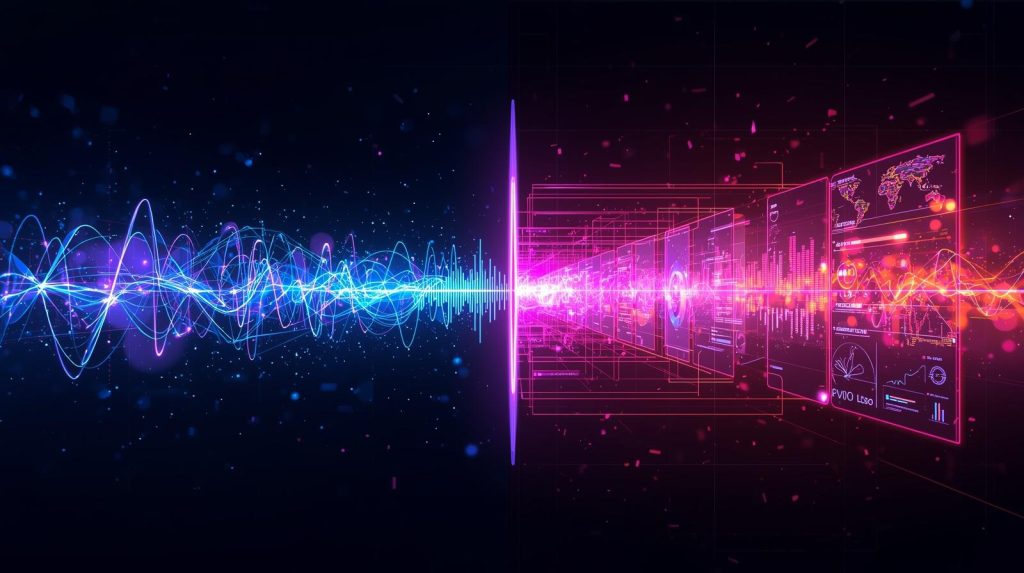
Real-Time Context Switching in AI: From Voice to Vision in Seconds
Meta Description: Discover how real-time context switching in AI enables instant voice-to-vision transitions, transforming industries and user experiences.
Introduction
Artificial Intelligence (AI) is no longer limited to single-purpose tasks. It’s evolving into multi-modal systems that can listen, see, and respond instantly. One of the most exciting breakthroughs in this space is real-time context switching in AI—the ability for machines to seamlessly shift between different modes of interaction, such as turning voice commands into visual outputs in seconds.
Picture this: you ask your AI assistant, “Show me a workflow diagram for my new project,” and within moments, your spoken words become a clear, structured visual. This isn’t futuristic fantasy—it’s happening right now.
The impact stretches across industries: personal assistants, customer support, robotics, healthcare, and creative design tools are all being reshaped by real-time AI.
What is Real-Time Context Switching in AI?
In simple terms, context switching is the ability to shift focus instantly without losing track. For AI, real-time context switching means adapting to different types of inputs—voice, text, images—and generating outputs just as smoothly.
Traditional AI models were limited: one handled speech, another managed text, and yet another processed images. Now, with multi-modal AI models like GPT-4o, Gemini, and other cutting-edge systems, a single model can understand and combine multiple data types at once.
This enables AI to interpret voice commands, text instructions, and visual cues and respond across modes in real time.
Why Voice-to-Vision Matters
Voice-to-vision AI isn’t just cool—it’s transformative. Humans naturally use multiple senses together, and AI is finally catching up.
When you speak to AI and instantly get a visual response, it makes communication faster, more intuitive, and more inclusive.
Key Benefits of Voice-to-Vision AI
- Speed: No more typing or drawing—your voice is enough.
- Accessibility: Voice helps those with mobility issues; visuals help those with hearing impairments.
- Better decisions: Real-time visuals speed up understanding in complex situations.
Examples in action:
- Voice-based sketching tools that draw what you describe.
- AR/VR assistants that project visuals instantly from spoken input.
- Smart devices that not only respond to your words but also show meaningful visuals.
The Technology Behind Real-Time AI Context Switching
This innovation is powered by a combination of advanced technologies:
- Multi-Modal AI Models
- Trained on text, voice, and images, enabling seamless cross-mode understanding.
- Trained on text, voice, and images, enabling seamless cross-mode understanding.
- High-Performance GPUs & Edge Computing
- Deliver the processing power needed for instant AI responses.
- Deliver the processing power needed for instant AI responses.
- Low-Latency Inference Systems
- Ensure that outputs appear in real time without delays.
- Ensure that outputs appear in real time without delays.
Current Challenges
- Synchronizing voice and visual data streams.
- Maintaining accuracy during rapid shifts.
- Handling the massive computational load required for real-time processing.
Real-World Applications
Real-time AI context switching is already being tested and applied in multiple industries:
- Healthcare: Doctors can dictate symptoms and instantly see diagnostic visuals.
- Education: Teachers describe a concept, and AI creates an instant diagram.
- Customer Support: Voice requests generate visual product demos or guides.
- Creative Tools: Designers can speak ideas that AI transforms into images or videos.
- Robotics & IoT: Voice commands can drive real-time robotic actions with visual feedback.
Advantages of Real-Time Context Switching
Adopting this technology unlocks huge advantages:
- Higher productivity with less manual work.
- Improved user experience through natural, intuitive interaction.
- Time savings with instant responses.
- Accessibility gains across diverse groups.
- Competitive advantage for early adopters.
Challenges and Limitations
Like any emerging technology, this comes with hurdles:
- Latency issues in large-scale deployments.
- Expensive infrastructure due to GPU and hardware needs.
- Ethical concerns, especially around deepfakes and misuse.
- Data privacy risks when handling sensitive multi-modal inputs.
Overcoming these challenges will require strong governance, transparency, and innovation.
The Future of Voice-to-Vision AI
Looking ahead, real-time context switching won’t stop at voice and vision. We’re moving toward AI that can combine speech, vision, gestures, touch, and even emotions.
- In the metaverse and AR/VR, AI could instantly build immersive worlds from spoken prompts.
- Autonomous systems like drones and vehicles could react to multi-modal inputs instantly.
- Wearable devices like smart glasses could display visuals in real time from your voice.
The future is one where AI doesn’t just listen or see—it does both simultaneously, just like we do.
Conclusion
Real-time context switching in AI is more than a buzzword—it’s a leap forward in how humans and machines connect. With the ability to move from voice commands to visual outputs in seconds, AI is breaking down barriers in communication, accessibility, and creativity.
Businesses that embrace this transformation today will lead tomorrow. The question isn’t whether real-time AI will reshape industries—it’s how fast you’ll adapt.
👉 Learn more here: Real-Time Context Switching in AI.
Final Thought: The future belongs to AI that can think, listen, and visualize—all at once. Are we ready to keep up?
Stay connected with us on HERE AND NOW AI & on:

